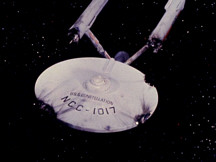 Diversifying Starfleet in TOS Diversifying Starfleet in TOS
Before the 2006 remastering of The Original Series, Federation ships besides the USS Enterprise were always depicted as a Constitution-class - mainly for budgetary reasons but also to indicate to the audience the threat posed by that week's villain, villainous entity or evil device. When the Remastering came around a decade and a half ago, the team decided to try and stay as faithful to TOS as possible, while also updating the effects - such as swapping the DY-100 Woden for the The Animated Series-derived "Antares-type" Woden.
Despite the original concept by Matt Jefferies that the Enterprise (no bloody A, B, C, or D) is the first ship in the 17th class commission by the Federation, "The Doomsday Machine", the sixth episode of season two, broke this concept with the only non-stock footage Constitution-class ship prior to the remasterings - the USS Constellation (NCC-1017). Such a low registry doesn't fit with either the Jefferies concept, or the generally-sequential registries in future series, the latter of which has become the convention accepted by both authors and fandom.
On this note, the premiere duology of Star Trek: Discovery introduced us to eight new Federation starship classes contemporary to the famous Constitution-class: Malachowski-class, Hoover-class, Nimitz-class, Cardenas-class, Engle-class, Shepard-class, Walker-class, Magee-class, followed by the Crossfield-class in episode three.
This glimpse into starships in service contemporaneously with the Constitution-class, coupled with their established registries in relation to the previously-established Constitution-class registries gives us ample opportunity to create a much more diverse Starfleet than seen in The Original Series, more on-par with the diversity seen in the later seasons of The Next Generation, as well as in First Contact and Deep Space Nine.
The registries, established either visually (hard canon) or via the Eaglemoss models (soft canon, as they come from the producers/writers), help place the established Star Trek: Discovery classes amongst the already-established registries from The Original Series and/or its remastering.
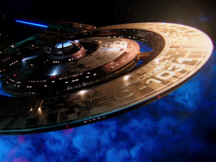 The lowest registries are given to two classes, the Engle-class, the USS T'Plana-Hath (NCC-1004) and the USS Earhart (NCC-1052) - the registry it is given in the Eaglemoss book Star Trek: Shipyards - Starfleet Ships 2151-2293 - and the Crossfield-class USS Glenn (NCC-1030) and the USS Discovery (NCC-1031). The lowest registries are given to two classes, the Engle-class, the USS T'Plana-Hath (NCC-1004) and the USS Earhart (NCC-1052) - the registry it is given in the Eaglemoss book Star Trek: Shipyards - Starfleet Ships 2151-2293 - and the Crossfield-class USS Glenn (NCC-1030) and the USS Discovery (NCC-1031).
The third episode of DSC, "Context is for Kings", it is commented that the Discovery, and, by inference, the Glenn, appear to be new ships because the shuttlebay floor is lacking in scratches. Assuming sequential registries, taking cues from Star Trek: The Motion Picture, and because of the specialized nature of both the Discovery and the Glenn, it may be the case that the Discovery and Glenn were retrofitted for spore drive research, instead of being dedicated ships. As well, from a resources point-of-view, it would be easier and cheaper to retrofit existing ships to be a testbed for a new, highly dangerous technology (as we saw with the Glenn), instead of committing resources to building a brand new class of starship for something that may not even work. In the case of the Excelsior, while it, in and of itself, was the test ship for transwarp, it was also the first in a new line of cruisers, a replacement for the Constitution-class. While we don't know much about what, exactly, Starfleet's transwarp was, considering it was equipped to a brand-new ship, it is likely a safe bet that, outside of some sort of unlikely extreme catastrophic failure, the transwarp drive was relatively safe.
These registries, even excluding the Earhart, comfortably place the USS Constellation not as being an oddly low-numbered Constitution-class, but, instead, makes it either an Engle or a Crossfield.
I skipped over the USS Whorfin (NCC-1024), because it is presumably the class ship of the already-established Whorfin-class - the SS Lakul and SS Robert Fox from Generations - which, in part or in whole, are intended to function as personnel transports.
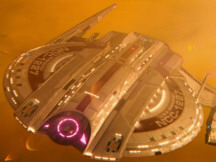 Next in line is the Walker-class USS Shenzhou (NCC-1227), and the Shepard-class trio: the USS Kerala (NCC-1255), the USS Ride (NCC-1265), and the USS Gagarin (NCC-1309). Next in line is the Walker-class USS Shenzhou (NCC-1227), and the Shepard-class trio: the USS Kerala (NCC-1255), the USS Ride (NCC-1265), and the USS Gagarin (NCC-1309).
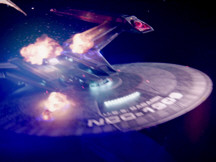 This leads us to Kirk's first ship, the USS Republic (NCC-1371). While often depicted or noted as being a Constitution-class (except in one 1980 comic where it is depicted as a Baton Rouge-class), her registry runs counter to the Jefferies concept, as well as the later-established norm of the USS Constitution being NCC-1700 - a stance held by licensed reference works, production personnel, and fandom at-large. However, it does put the Republic in position to be a "late-run" Shepard, or, more likely, a Magee-class, due to a closer proximity in registries. This leads us to Kirk's first ship, the USS Republic (NCC-1371). While often depicted or noted as being a Constitution-class (except in one 1980 comic where it is depicted as a Baton Rouge-class), her registry runs counter to the Jefferies concept, as well as the later-established norm of the USS Constitution being NCC-1700 - a stance held by licensed reference works, production personnel, and fandom at-large. However, it does put the Republic in position to be a "late-run" Shepard, or, more likely, a Magee-class, due to a closer proximity in registries.
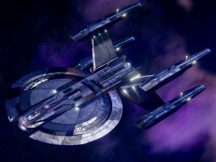 That takes us to the Magee-class USS Shran (NCC-1413), then the Cardenas-class duo: Lorca's ship, USS Buran (NCC-1422), and Ash Tyler's ship, the USS Yeager (NCC-1437), followed by a large jump to the Malachowski-class USS Sioux (NCC-1621). That takes us to the Magee-class USS Shran (NCC-1413), then the Cardenas-class duo: Lorca's ship, USS Buran (NCC-1422), and Ash Tyler's ship, the USS Yeager (NCC-1437), followed by a large jump to the Malachowski-class USS Sioux (NCC-1621).
I hopped the USS Scovill (NCC-1598), as its only mention being on a barely-legible screen on the Enterprise-A bridge in The Undiscovered Country, and on unseen pages of the Operation: Retrieve plan prop, and it falls into the large gap between the Yeager and the Sioux, leaves any sort of determination impossible.
Next is another out-of-place Constitution-class, the USS Intrepid (NCC-1631). Its registry puts it between the Sioux and the Nimitz-class USS Europa (NCC-1648), making it either a Malachowski or a Nimitz.
Again, we have an out-of-place Constitution-class, the USS Potemkin (NCC-1657), another ship that participated in the M-5 war games with the 1701. It is likely a Malachowski-class, based on the immediate proximity of its registry to the USS Clarke (NCC-1661). However, it should be noted that in The Undiscovered Country, it was depicted as a refit-Constitution on the Operation: Return charts, but there are a number of unresolved questions related to the depiction of ships on the charts, such as the USS Emden's silhouette suddenly changing size between pages. Because, at the time of filming in 1990, the chart wasn't intended for analytical viewing, nor was it clearly visible on screen - it was only five years ago that a detailed inspection was available - so such silhouettes can be written off in a similar manner to other "low-res" background graphics of the 1980s and 1990s.
We then have the aforementioned Malachowski-class USS Clarke (NCC-1661), then two out-of-place Constitution-classes, the USS Excalibur (NCC-1664), another M-5 war games ship, and the USS Exeter (NCC-1672), the ship that went to Omega IV. Being NCC-1664, the Excalibur is soundly in Malachowski territory. Based on the size of the Malachowski-class, the Excalibur being a Malachowski-class lends credence to having her crew killed by a full power phaser blast with shields at minimal over being a Constitution-class - while the Exeter straddles the Malachowski/Hoover line, with her registry, NCC-1672, sitting exactly halfway between the Clarke (NCC-1661) and the Hoover-class USS Edison (NCC-1683).
The "orphaned" registry of NCC-1685 and the USS Helin (NCC-1692), like the Scovill, its only mention being on a barely-legible screen on the Enterprise-A bridge in The Undiscovered Country, and on unseen pages of the Operation: Retrieve plan prop, are both "undefined", though, through their proximity to the Edison's registry, it can be inferred they may be Hoover-class, as well.
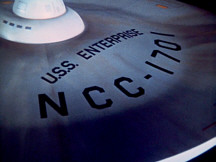 That brings us, at last, to the ol' girl herself, the USS Enterprise (NCC-1701). That brings us, at last, to the ol' girl herself, the USS Enterprise (NCC-1701).
So, the new arrangement becomes:
- USS T'Plana-Hath NCC-1004 Engle-class
- USS Constellation NCC-1017 Engle/Crossfield
- USS Glenn NCC-1030 Crossfield-class
- USS Discovery NCC-1031 Crossfield-class
- USS Earhart NCC-1052 Engle-class
- USS Shenzhou NCC-1227 Walker-class
- USS Kerala NCC-1255 Shepard-class
- USS Ride NCC-1265 Shepard-class
- USS Gagarin NCC-1309 Shepard-class
- USS Republic NCC-1371 Shepard/Magee
- USS Shran NCC-1413 Magee-class
- USS Buran NCC-1422 Cardenas-class
- USS Yeager NCC-1437 Cardenas-class
- USS Sioux NCC-1621 Malachowski-class
- USS Intrepid NCC-1631 Malachowski/Nimitz
- USS Europa NCC-1648 Nimitz-class
- USS Potemkin NCC-1657 Malachowski-class
- USS Clarke NCC-1661 Malachowski-class
- USS Excalibur NCC-1664 Malachowski-class
- USS Exeter NCC-1672 Malachowski/Hoover
- USS Edison NCC-1683 Hoover-class
- USS unknown NCC-1685 Hoover-class
- USS Helin NCC-1692 Hoover-class
- USS Enterprise NCC-1701 Constitution-class
Using the USS Enterprise as our base, and building out from the screen-established registries as presented in both the remastered The Original Series and in Discovery, this allows us to use the generally-accepted sequential registries to diversify the 2260s Starfleet to a level more on-par with Starfleet a century later.
(Theory by Ryan Dietz)
| 
